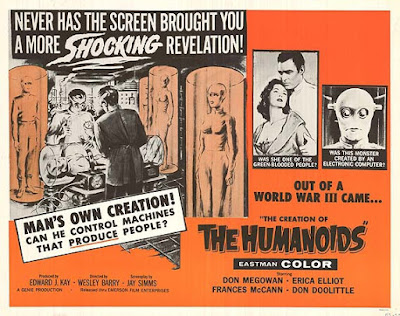This
eighty-four-minute American science fiction double feature was
directed by Wesley Barry for Genie Productions Inc. and released by
Emerson Film Enterprises. Who knew? The Eastman color is rich and
dense with cinematography work by Hal Mohr enhancing the simplistic
and colorful set designs—highly interpretive as if for a modern
stage play. But Shakespeare this is not. Most of the lowly budget was
spent on paper to print the massive scripts that rival Congress's
pork projects. Jay Simms created the most talkative film of the
Sixties. Through its knee-deep dialogue, it attempts to convince the
viewer that humans and humanoids share many similarities. This film
is a real technical head-scratcher, so it is pointless to divulge any
of its fictitious jargon.
From
the pessimistic Hollywood playbook comes the story that most of
humanity has been destroyed by a nuclear war. Humanoids are an
advanced type of robot that work closely with humans. They are
created from man's unique ability to learn, his memory, his
personality, and his philosophy. The uppity “oids” seem a wee bit
condescending. Today, they may visually remind one of the future
Ernst Blofeld, played by Donald Pleasence, in You Only Live
Twice. Like Blofeld, they dress in “Communist” uniforms with
their banded collars. These Godless humanoids routinely recharge at
stations they call "temples" and exchange information with
a central computer known devotedly as "the father-mother." Their glowing
eyes are creepily well done.
"The
Order of Flesh and Blood" is obviously the humans. They are
constantly assessing the humanoids whom they fear are planning to
take over the world. They do seem to be quick learners. One local OFB
union leader is played by the towering Dan Megowan, who may be the
only familiar face in the film due to his many television western
roles. There is a love interest, of sorts, which becomes a real
eye-opener for him. The wardrobe for all OFB members are sleek “Bob
Mackie” versions of a Confederate soldier's uniform of powder blue
shirts combined with a reflective material topped off by a period
“Rebel” cap. Jazz hands! Certainly non-issue during the Civil
War.
Note: The
film suggests humans should not judge humanoids too harshly. Their
words might come back to haunt them. Increasingly, humans have
difficulty recognizing themselves. A sly, thought-provoking ending
comment by the film's research doctor intimates that identity is
deeper than mere appearance.




















